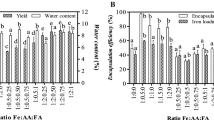Abstract
Iron fortification of foods continues to be one of the preferred ways of improving the iron status of the population. Dairy product is a common product in the diet; therefore, it is a plausible vehicle for iron fortification. This study aims to investigate the bioavailability of ferrous gluconate stabilised with glycine (FGSG) in a fresh cheese fortified with zinc. The iron bioavailability of fresh cheese fortified with either FGSG and with or without zinc and FGSG in aqueous solution and a water solution of ferrous ascorbate (reference dose) was studied using double radio iron (55Fe and 59Fe) erythrocyte incorporation in 15 male subjects. All subjects presented with normal values for iron status parameters. The geometric mean of iron bioavailability for the water solution of FGSG was 38.2 %, adjusted to 40 % from reference doses (N.S.). Iron bioavailability in fresh cheese fortified with Ca and Zn was 15.4 % and was 23.1 % without Zn, adjusted to 40 % from reference doses (N.S.). The results of the present study show that the novel iron compound ferrous gluconate stabilised with glycine in a fresh cheese matrix is a good source of iron and can be used in iron fortification programmes.
Similar content being viewed by others
References
CDC (1998) Recommendations to prevent and control iron deficiency in the United States. Centers for Disease Control and Prevention. MMWR Recomm Rep 47: 1–29
Boccio J, Salgueiro J, Lysionek A et al (2003) Current knowledge of iron metabolism. Biol Trace Elem Res 92:189–212
Brune M, Rossander-Hulten L, Hallberg L et al (1992) Iron absorption from bread in humans: inhibiting effects of cereal fiber, phytate and inositol phosphates with different numbers of phosphate groups. J Nutr 122:442–449
Boccio J, Salgueiro J, Zubillaga M et al (2002) Zinc and iron interactions evaluated between different mineral sources in different nutritional matrixes. Food Nutr Bull 23(suppl 3):s195–s198
Stekel A, Olivares M, Pizarro F et al (1986) Absorption of fortification iron from milk formulas in infants. Am J Clin Nutr 43:917–922
Fischer DS, Price DC (1964) A simple serum iron method using the new sensitive chromogen tripyridyl-s-triazine. Clin Chem 10:21–31
International Anemia Consultative Group (1985) Measurement of iron status: a report of the international anemia consultative group. The Nutrition Foundation, Washington
Eakins I, Brown D (1966) An improved method for the simultaneous determinations of 55-iron and 59-iron in blood by liquid scintillation counting. Int J Appl Radiat Isot 17:391–397
Nadler SB, Hidalgo IV, Block T (1962) Prediction of blood volume in normal human adults. Surgeon 51:224–232
Bothwell TH, Charlton RW, Cook JD et al (1979) Iron metabolism in man. Blackwell, Oxford
Lysionek A, Zubillaga M, Salgueiro J et al (2003) Stabilized ferrous gluconate as iron source for food fortification. Bioavailability and toxicity studies in rats. Biol Trace Elem Res 94:73–77
Janjetic M, Barrado A, Torti H et al (2006) Iron bioavailability from fortified petit suisse cheese determined by the prophylactic–preventive method. Biol Trace Elem Res 109:195–200
Bezwoda W, Torrance J, Bothwell T et al (1985) Iron absorption from red and white wines. Scand J Haematol 34:121–127
Charlton R, Bothwell T (1993) Iron absorption. Annu Rev Med 34:55–68
Bothwell T, Baynes R, MacFarlane B et al (1989) Nutritional iron requirements and food iron absorption. J Intern Med 226:357–365
Schumann K, Elsenhans B, Ehtechami C et al (1990) Rat intestinal iron transfer capacity and the longitudinal distribution of its adaptation to iron deficiency. Digestion 46:35–45
Siegenberg D, Baynes R, Bothwell T et al (1991) Ascorbic acid prevents the dose-dependent inhibitory effects of polyphenols and phytates on nonheme-iron absorption. Am J Clin Nutr 53:537–541
Olivares M, Hertrampf E, Pizarro F (1993) Effect of iron stores on heme iron absorption. Nutr Res 13:633–638
Pizarro F, Olivares M, Hertrampf E et al (1994) Factores que modifican el estado de nutrición de hierro: contenido de taninos en infusiones de hierbas. Arch Latinoam Nutr 44:277–280
Minotti P, Buchonski S, Miller D (1993) Effects of calcium supplementation, calcium source and lactose on iron absorption in the rat. Nutr Res 13:1173–1181
Reddy M, Hurrell R, Cook J (2000) Estimation of nonheme-iron bioavailability from meal composition. Am J Clin Nutr 71:937–943
Cook J, Dassenko S, Whittaker P (1991) Calcium supplementation: effect on iron absorption. Am J Clin Nutr 53:106–111
Hallberg L, Rossander-Hulthen L, Brune M et al (1992) Calcium and iron absorption: mechanism of action and nutritional importance. Eur J Clin Nutr 46:317–327
Gleerup A, Rossander-Hulten L, Hallberg L (1993) Duration of the inhibitory effect of calcium on non-haem iron absorption in man. Eur J Clin Nutr 47:875–879
Reddy M, Cook J (1997) Effect of calcium intake on nonheme-iron absorption from a complete diet. Am J Clin Nutr 65:1820–1825
Hallberg L (1998) Does calcium interfere with iron absorption? Am J Clin Nutr 68:3–4
Salgueiro MJ, Zubillaga M, Lysionek A et al (2002) Strategies to combat zinc and iron deficiency. Nutr Rev 60:52–58
Magnusson G, Bjorn-Rasmussen E, Hallberg L et al (1981) Iron absorption in relation to iron status. Model proposed to express results to food iron absorption measurements. Scand J Hematol 27:201–208
Uicich R, Pizarro F, Almeida C et al (1999) Bioavailabilioty of microencapsulated ferrous sulfate in fluid cow’s milk. Studies in human beings. Nutr Res 19:893–897
Allen L, Benoist B, Dary O et al (2006) Guidelines on food fortification with micronutrients. WHO/FAO, Geneva
Acknowledgments
We would like to thank Stephane Doat and Angélica Letelier for his excellent technical assistance. This study was supported by funding from Danone Research, Argentina.
Author information
Authors and Affiliations
Corresponding author
Rights and permissions
About this article
Cite this article
Pizarro, F., Boccio, J., Salgueiro, M. et al. Bioavailability of Stabilised Ferrous Gluconate with Glycine in Fresh Cheese Matrix: a Novel Iron Compound for Food Fortification. Biol Trace Elem Res 151, 441–445 (2013). https://doi.org/10.1007/s12011-012-9574-7
Received:
Accepted:
Published:
Issue Date:
DOI: https://doi.org/10.1007/s12011-012-9574-7




